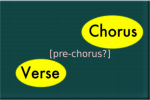A pre-chorus can go a long way to building energy and excitement in a song. Here are some handy tips.
 Download “The Essential Secrets of Songwriting” 10-eBook Bundle, and increase your song’s HIT potential. Get a copy of “Use Your Words! Developing a Lyrics-First Songwriting Process” FREE with your purchase of the Bundle
Download “The Essential Secrets of Songwriting” 10-eBook Bundle, and increase your song’s HIT potential. Get a copy of “Use Your Words! Developing a Lyrics-First Songwriting Process” FREE with your purchase of the Bundle
 A pre-chorus is the short section that sits between a verse and a chorus, and its main purpose is to build energy. A most recent example is Katy Perry’s “Firework,” with the pre-chorus starting with the words, “You just gotta ignite the light…” There are no rules regarding how long a pre-chorus needs to be, and no rules that state that a particular song must have a pre-chorus. Certain songs will benefit from the energetic build-up that happens when those extra bars are added, so take a look at the following 5 things you should know about writing a pre-chorus.
A pre-chorus is the short section that sits between a verse and a chorus, and its main purpose is to build energy. A most recent example is Katy Perry’s “Firework,” with the pre-chorus starting with the words, “You just gotta ignite the light…” There are no rules regarding how long a pre-chorus needs to be, and no rules that state that a particular song must have a pre-chorus. Certain songs will benefit from the energetic build-up that happens when those extra bars are added, so take a look at the following 5 things you should know about writing a pre-chorus.
Songs that exhibit the following characteristics are often good candidates for a pre-chorus:
- The verse melody is similar or identical to the chorus melody. Sugarland’s 2010 hit “Stuck Like Glue” is a good model for this. Where the verse and chorus melodies play around with the same notes in the same basic range, a pre-chorus can offer an opportunity for a new melody.
- The verse melody is short. John Lennon’s “Imagine” is a good example here. The verse is comprised of a very catchy but simple melodic shape that’s repeated over and over. The pre-chorus (“Imagine all the people…”) helps to build energy, and connect the verse to the chorus more satisfactorily than simply jumping to the chorus from the verse.
- The verse chord progression is simple, and doesn’t really get going. “Imagine” is a good demonstration of this point as well. If you find yourself writing a verse that moves back and forth between two chords, you may want to allow the music to move a bit further afield before entering the chorus.
- The melodic range of the verse and chorus are very different. This is the situation in “Firework” that is solved by the pre-chorus. In “Firework,” the verse ends on a low Ab, and the chorus begins on a Eb, an octave-and-a-half higher. The pre-chorus allows the melody to work its way upward to make a smoother connection.
- The verse lyrics need a more obvious build to match the emotion of the chorus. Shontelle’s “Impossible” shows this clearly. Simply remove the words of the pre-chorus (“And now when all is done/ there is nothing to say/ you have gone and so effortlessly/ you have won, you can go ahead tell them..”) and you can see how unpleasantly abrupt it feels to move directly from the verse to the chorus.
For example, the verse for “Imagine” consists of 4 equal-length phrases. The pre-chorus adds an extra 2 phrases before entering the chorus. And it’s very common to have a pre-chorus that does not conform to the 2-, 4- or 8-phrase rule.
Not every song needs a pre-chorus, and often it’s created right along with the verse and chorus, as opposed to something that’s added in later. But if you find yourself looking at your song and wondering what to do to enhance the build between verse and chorus, consider the power that can come from a pre-chorus.
Written by Gary Ewer, from “The Essential Secrets of Songwriting” website
Follow Gary on Twitter
 “The Essential Secrets of Songwriting” 10-eBook bundle will show you how to write great songs, harmonize your melodies, and give you hundreds of chord progressions in the process.
“The Essential Secrets of Songwriting” 10-eBook bundle will show you how to write great songs, harmonize your melodies, and give you hundreds of chord progressions in the process.
PURCHASE and DOWNLOAD the e-books for your laptop/desktop










Pingback: Finding a Good Chord Progression For Your Song’s Pre-Chorus | The Essential Secrets of Songwriting
Pingback: Creating a Good Chord Progression For a Pre-Chorus | The Essential Secrets of Songwriting